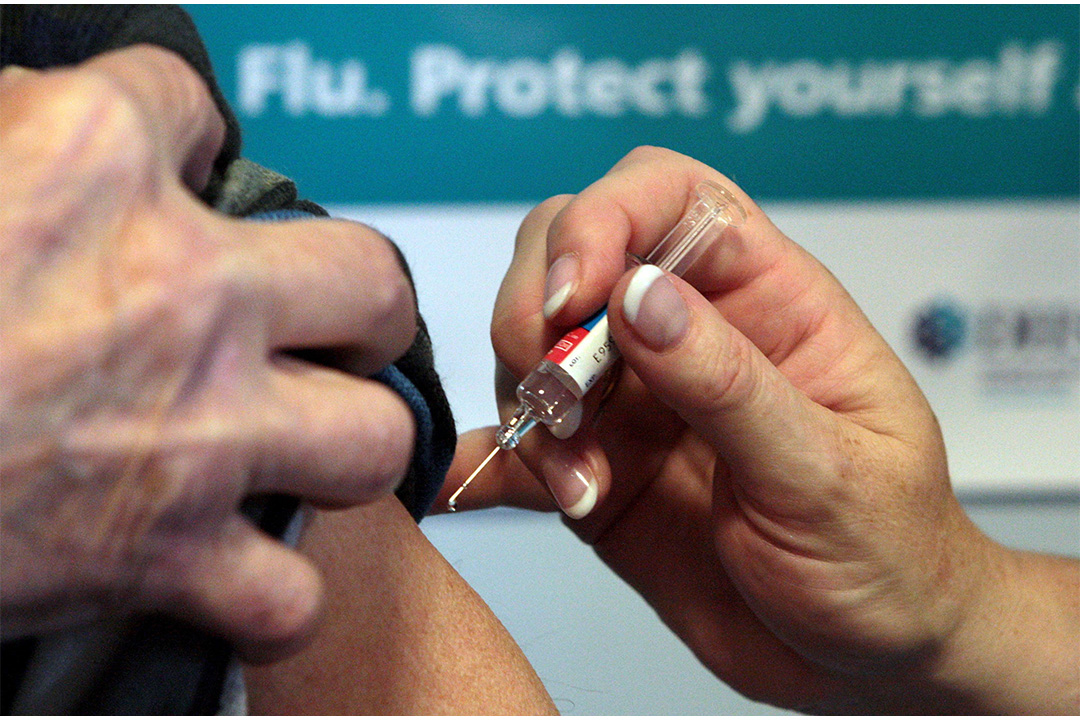

Despite a messy US jobs report on Friday, global shares mostly rose over the last week as the US debt ceiling was pushed out to December and there was some easing in concerns regarding the European energy crunch.
For the week US shares rose 0.8%, Eurozone shares rose 0.7% and Chinese shares rose 1.3%, but Japanese shares fell -2.5%. The positive global lead saw Australian shares rise 1.9% led by energy, utility, financial and material shares. Consistent with a bit of “risk on” along with still rising inflation concerns bond yields rose as did oil, metal & iron ore prices along with the $A.
Some relief of some worries
As we noted last week, there is a long list of worries pushing shares around at present. And while they remain, there have been some signs of relief in regards to some of them.
The good news
The good news is that Russian President Vladimir Putin has offered to increase gas supply to Europe (where prices have risen six-fold since earlier this year) although it may come with some strings attached (eg speeding up the certification of the Nord Stream 2 gas pipeline). Likewise, there are some signs China is easing restrictions on coal and electricity supply.
Improvement on some fronts
China Evergrande is yet to be resolved and other developers are having problems – but the Chinese Government appears to be stepping up efforts to limit the fallout and protect healthy developers, home buyers and the property market (but maybe not global bondholders).
Supply constraints and rising bond yields
This is perhaps the biggest issue. As the world goes back to work and consumer spending rotates away from goods back to services then the bottlenecks should start to resolve but this is taking longer than expected risking higher and more entrenched inflation and hence higher bond yields. Too rapid a rise in bond yields can create problems for shares if earnings struggle to keep up.
Shares bouncing along but…
In short, the good news on some of these issues in the last week is helping shares bounce, but the risk is high that the correction may run a bit further. That said, we ultimately see the issues being largely resolved in a way that does not severely threaten global growth and so with global monetary policy likely to remain relatively easy for some time, we continue to see the broader trend in shares remaining up.
Worry about heat in the property market
The RBA’s Financial Stability Review highlights rising systemic risks around rapid growth in home lending as APRA kicks off macroprudential tightening to cool it down, with more likely on the way. The RBA’s FSR notes that households and businesses were generally in a sound position heading into the Delta variant lockdowns and sees only a small share as being vulnerable to them and the overall financial system as sound.
However, it reiterated concerns about rising growth in household debt, the likelihood that it will accelerate further and the rise in loans with high debt to income ratios. All of which is consistent with APRA’s directive to banks to increase the interest rate buffer used to assess how much borrowers can borrow from 2.5% to 3%. This means that with an interest rate of 2.7% borrowers will need to be able to service the loan even if rates rise to 5.7%, up from 5.2%.
Reducing the amount that can be borrowed may help slow housing credit growth, but the impact is likely to be modest at around a 5% reduction for a typical borrower and in any case, 90% or so of borrowers borrow less than their allowed capacity and some banks had already raised their serviceability buffers.
The move adds a headwind to house price growth along with worsening affordability, reduced government incentives, a likely rise in fixed mortgage rates and rising listings, but is unlikely to be enough to push prices down. Given we had already allowed for macro prudential tightening we will stick to our expectation for average home price growth to slow to 7% next year from 21% this year. However, APRA has indicated that its prepared to do more and will release a paper covering various options later this year and the RBA has also discussed the merits of various options in its latest FSR. As such, with APRA’s initial move unlikely to close the gap between housing credit growth and household income growth we expect more macro prudential measures from later this year or early next year.
Going by the RBA’s analysis this could involve some combination of further action in terms of serviceability buffers along with debt to income and loan to valuation restrictions. This is likely along with higher fixed mortgage rates and perhaps higher variable rates to start home pushing prices down in 2023.
Coronavirus update
The news on coronavirus is mostly good. New global coronavirus cases are trending down with most regions flat or falling. This includes the US, although Europe is edging up again.
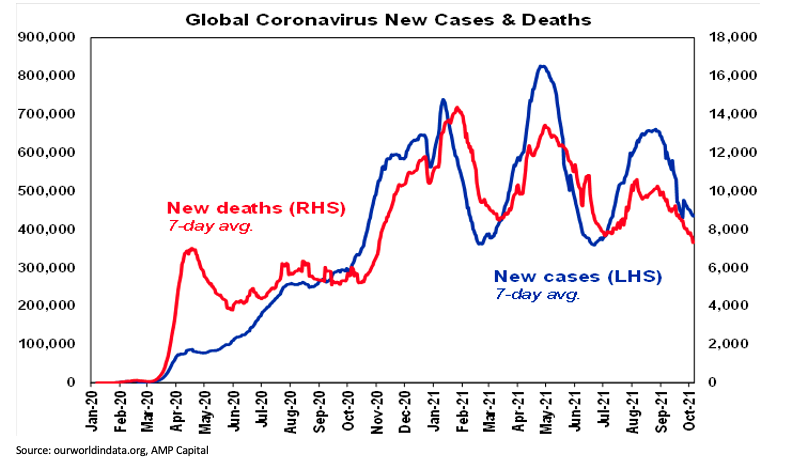
Modern medicine seems to be getting the upper hand against coronavirus – with vaccines helping to keep hospitalisations and deaths down in more heavily vaccinated countries and US states, booster shots being rolled out to help deal with declining vaccine (mainly Pfizer) efficacy after about 5 to 6 months (notably in Israel) and a new Merck drug appearing to reduce the risk of coronavirus hospitalisation and death in clinical trials by 50% and now seeking approval for emergency use. Hospitalisations and deaths in the UK are remaining very subdued given the number of new cases compared to the previous wave.
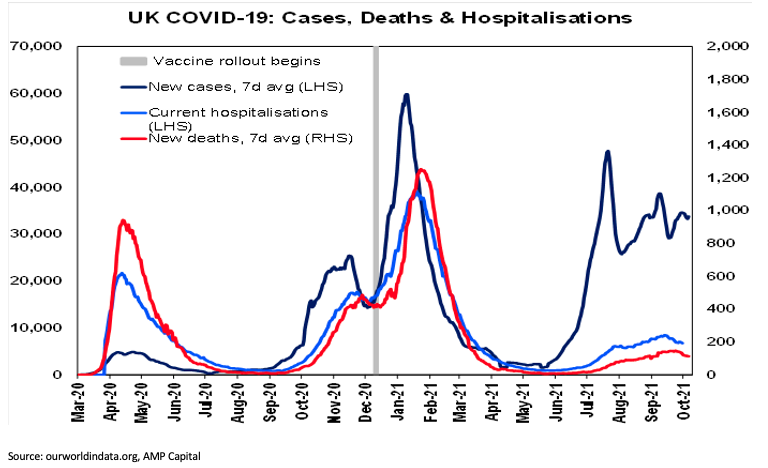
Vaccination update
Finally, vaccination rates are continuing to rise, albeit slowly. 48% of people globally and 72% in developed countries have now had at least one dose of vaccine.
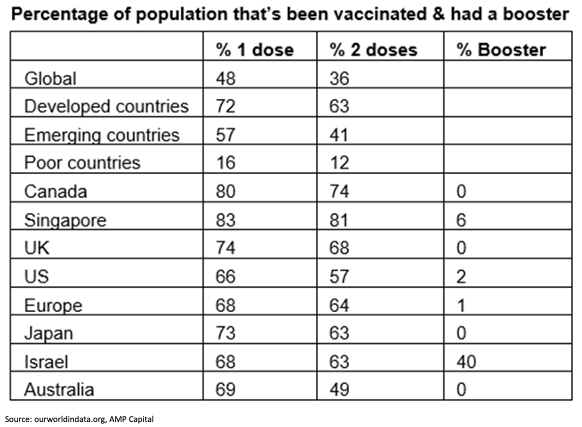
A major test will come in the northern winter – particularly as vaccine efficacy starts to wear off in some countries in the absence of rapid booster programs. And risks remain around the low level of vaccination in poor countries and the possibility of more transmissible/more deadly mutations. But so far good and all this is seeing further reopening in developed countries.
Local Covid story
In Australia, new cases are still surging in Victoria, but NSW which led by about a month is seeing a sharp decline.
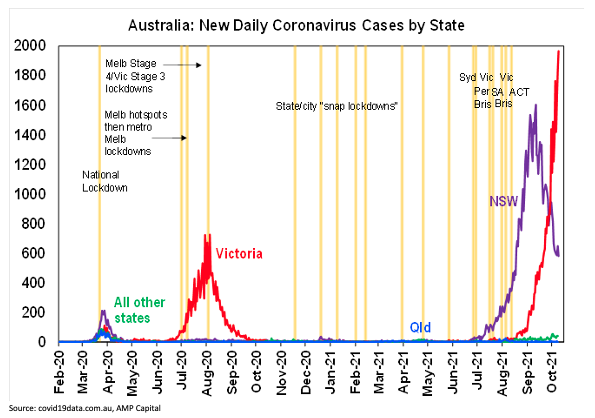
69% of Australia’s whole population has now had at least one vaccine dose, which is more than the US. For first doses for adults, the ACT is now well above 90%, NSW is nearly at 90% (so much for the reported vaccine hesitancy), Victoria will reach 90% in around two weeks and Australia is now through 80%.
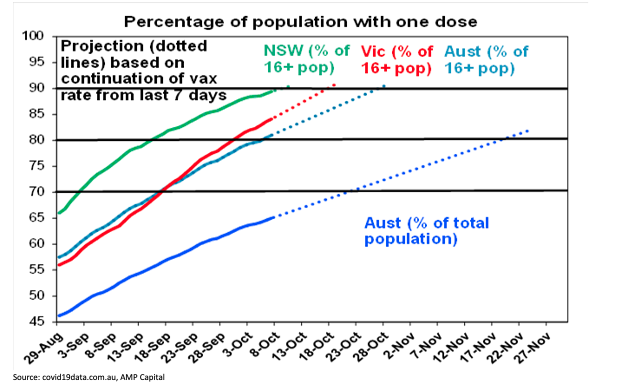
On the basis of projections based on current trends for first doses and the average gap between 1st and 2nd doses, the following table shows when key vaccine targets will be met. NSW and the ACT (not shown) have already hit the 70% of adults double vax target and NSW will hit 80% around 20 October, Victoria will hit 70% around 26 October and Australia on average around 24 October.
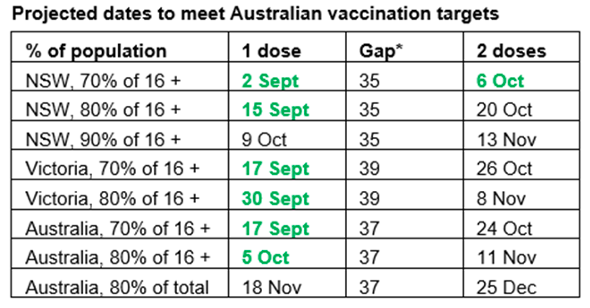
*Current gap in days between 1st and 2nd doses. Source: AMP Capital
Freedom update
Having met the 70% of adults double vax target NSW will start reopening today. For Victoria, it will be late October/early November (cases permitting) and the ACT (not shown) early October. Other states and territories will hit the 70% target in mid-November.
Singapore’s experience highlights the need for the reopening to be gradual. The experience in Singapore which is now seeing more than 3000 new cases a day after reopening highlights the risks involved in reopening too rapidly – as a sudden surge in new cases can quickly overwhelm the hospital system necessitating a reversal in the easing of restrictions. NSW’s decision to speed up its relaxation of social restrictions from Monday poses a bit of a risk on this front as still only 59% of the whole NSW population will have been fully vaccinated compared to 81% in Singapore – so this is something to watch.
Meanwhile, vaccination is continuing to help keep serious illnesses down. Coronavirus case data for NSW shows that the fully vaccinated make up a low proportion of cases, hospitalisations and deaths.
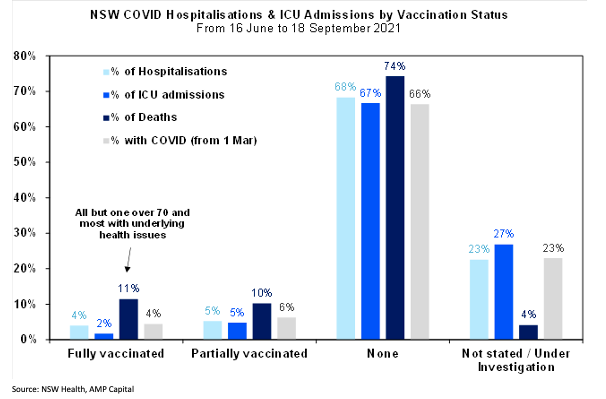
The level of deaths (the red line in the next chart) is running at around 20% of the level predicted on the basis of the previous wave (dashed line). On this basis, the vaccines are helping save roughly 54 lives a day at present.
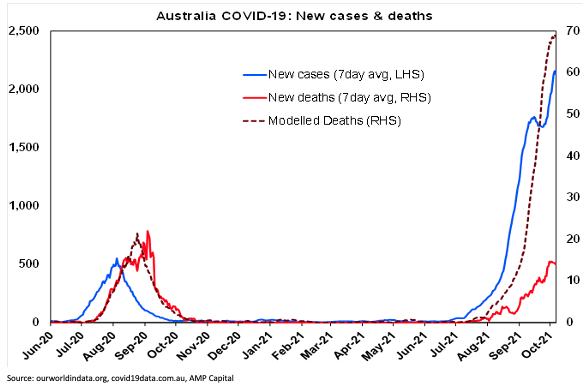
Elvis on tour
Elvis roared back in 1972 with Elvis On Tour, another mega hit in Burning Love (that he was initially lukewarm warm on as he wanted to become more middle of the road) and the classic Always On My Mind (where Mark James who wrote Suspicious Minds and Moody Blue was one of the songwriters). Separate Ways written by his friend Red West seemed like it was specifically written for Elvis given his split from Priscilla.